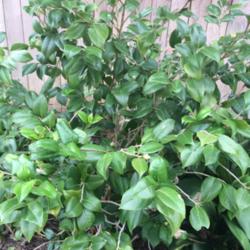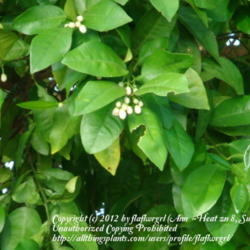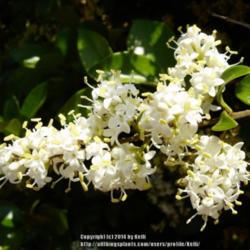Hi fraz1:
Here's some additional information about Viburnum davidii from the Flora of China, Vol. 19 Adoxaceae p. 583.
18. Viburnum davidii Franchet, Nouv. Arch. Mus. Hist. Nat., sér. 2, 8: 251. 1885 [“davidi”].
川西荚蒾 chuan xi jia mi
"Shrubs, evergreen, to 10 m tall. Bark gray-brownish. Branchlets of current year purple-brownish, with raised lenticels, subglabrous; branchlets of previous year gray-whitish, terete, glabrous, with numerous, large, rounded lenticels. Winter buds ovoid, with 1 pair of separate scales; scales reddish brown, glabrous, apex acute. Leaves always opposite, not clustered at apices of branchlets; stipules absent; petiole purplish, robust, 0.8–2.5(–3) cm, glabrous; leaf blade purplish when young, elliptic-obovate to elliptic, 6–14 × 4–7 cm, thickly leathery, lustrous and conspicuously rugose, abaxially yellowish stellate-pubescent only in axils of veins, adaxially glabrous, midvein raised abaxially, triplinerved, veins pinnate, arched, rarely branched, anastomosing near margin, raised abaxially, impressed adaxially, veinlets transverse, conspicuous abaxially, deeply impressed and conspicuously rugose adaxially, not lobed, base broadly cuneate to subrounded, without glands, margin entire orsometimes with few irregular teeth above middle part, apex shortly acuminate. Flowers appearing after leaves; inflorescence a compound umbel-like cyme, terminal, 4–6 cm in diam.; rays whorled; first node of inflorescence with 5 or 6 rays, 1–3 cm, dense, glabrous, without large sterile radiant flowers; peduncles (1–)1.5–3(–3.5) cm; bracts caducous, leaflike, green, linear to linear-lanceolate, glabrous; bracteoles scalelike. Flowers on rays of 2nd order, not fragrant, with very short pedicels. Calyx greenish; tube campanulate, ca. 1 mm, glabrous; lobes lanceolate, very small, ca. 1/2 as long as tube, glabrous, apex acute. Corolla white, rotate, ca. 5 mm in diam., glabrous; tube ca. 1 mm; lobes spreading, orbicular, ca. 2 mm in diam., 2–4 × as long as tube, apex rounded, margin entire. Stamens ca. 1/2 as long as corolla, inserted near base of corolla tube; filaments ca. 2 mm; anthers red-blackish, subglobose, less than 1 mm. Styles nearly as long as calyx lobes; stigmas subsessile. Fruit not turning red, maturing blue-blackish, ovoid or ellipsoid-oblong, ca. 6 × 4 mm, base rounded, apex acute, glabrous; pyrenes globose, 4–5 mm in diam., with 1 small and shallow ventral groove, apex rounded. Fl. Jun, fr. Sep–Oct. 2n = 18*."
● Mountains; 1800–2400 m. W Sichuan.
*********************************************************
All that is to say: Viburnums are NOT dioecious plants. They are monoecious, with perfect flowers, but are typically self-incompatible (like many species in Rosaceae). That means, they do not pollinate themselves well (though some fruit can be produced when solitarily planted), but cross-pollinate well with similar plants in their vicinity with the help of the insects which visit their flowers and move the pollen around.
So - one Viburnum davidii planted as a solitary individual produces relatively few fruit, but multiple Viburnum davidii seedlings or of dissimilar parentage planted together will fruit heavily on all plants.
I am an evidence-based guy, however. I say to inspect the flowers of the plants in question, and if you find only staminate parts or only pistillate parts in said flowers - and post pictures here of such inspection's findings - then I stand to be persuaded.
See also:
Viburnum (Lloyd Kenyon, 2001, NCCPG)
From p. 36 description of Viburnum davidii: "V. davidii is said to be dioecious, that is displaying staminate and pistillate flowers on different plants, and to require planting of male and female plants together to ensure fruiting. Whilst there is undoubted evidence that single plants are reluctant to set seed, this is more likely to be a consequence of the natural unwillingness of the genus as a whole to self-pollinate, rather than a more fundamental difference between one species and the whole of the rest of the genus."
AND from p. 10 paragraph on Fruiting: "...the genus as a whole shows a reluctance to self-pollinate. They will always give a more reliable display of fruit if there has been pollination from another species or a nearby plant of the same species (preferably from a different clone). The case of V. davidii is interesting, where for a long time it was held that the plant was dioecious, that is, having male flowers on one plant and female flowers on another. While 'male' and 'female' plants are still sold separately by some nurserymen, it is much more likely that this is nothing more than a greater emphasis being placed on the rejection of self-pollination than the anomalous sexual behaviour of one species out of the whole genus."
Lord Kenyon is the holder of a NCCPG National Plant Collection of Viburnum.
Viburnums: Flowering Shrubs for Every Season (Michael A. Dirr, 2007, Timber Press) is another source of documentation on all things Viburnum, and echoes the information provided herein. From p. 15:
"For best fruit set, another seedling or clone of the same or closely related species should be in proximity. Viburnums trend toward self-sterility, meaning pollen from the same flower will not successfully pollinate and fertilize the ovules (forerunners of seeds) of that flower. I have noticed this in V. dilatatum, less so in V. dentatum, where isolated specimens set reasonable fruit."
I wish you success with your garden plants.


